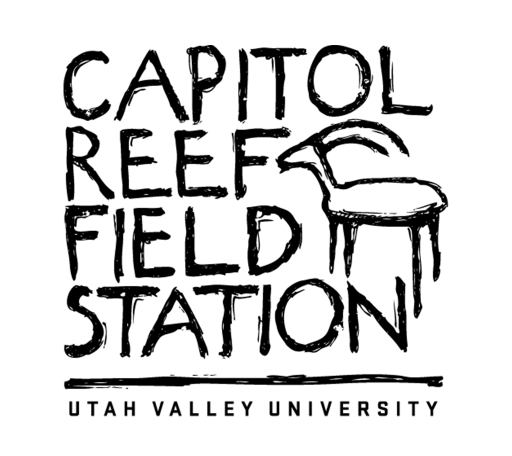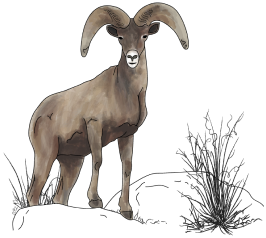Pinus edulis Engelm.
Viridiplantae > Streptophyta > Streptophytina > Embryophyta > Tracheophyta > Euphyllophyta > Spermatophyta > Acrogymnospermae > Pinopsida > Pinidae > Conifers I > Pinales > Pinaceae > Pinus > Pinus subgen. Strobus > Pinus edulis [1]
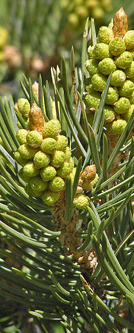
Needles and immature male cones on a Pinus edulis specimen in Mesa Verde National Park, Colorado. Photo taken May 31, 2004 by Al Schneider [24].
Trees with pyramidal to rounded crowns, 5-15(-20) m tall, the trunk short. Bark thin and scaly, yellowish-brown to reddish-brown, ultimately furrowed and grayish. Needles 2 per cluster, 1.5-5 cm long, rigid, sharply pointed, the sheath deciduous. Staminate cones 3-6 mm long. Ovulate cones ovoid, (2)3-5 cm long, short-stalked, yellowish-brown to brown, resinous, the scales thickened apically but without a prickle, the umbo dorsal, inconspicuous seeds brown, mainly 8-16 mm long, ovoid-ellipsoid to ellipsoid, thick-shelled, wingless, averaging smaller than Pinus monophylla [2].
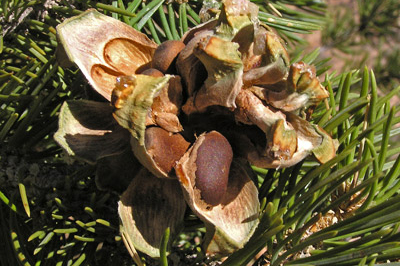
Needles and mature female cones with seeds of Pinus edulis. Specimen found growing at Canyons of the Ancients National Monument, Colorado. Photo taken May 25, 2016 by Al Schneider [23].
Pinus edulis can be distinguished from Pinus monophylla (Single-Needle Pinyon Pine / Colorado Pinyon) by its 2 needles per cluster relative to the single needles in P. monophylla [3]. Pinus monophylla is known as a soft shell pine nut due to a seed coat that can be easily dented with a fingernail whereas P. edulis is known as a hard-shell pine nut because it takes much more effort to crack [4].
Specimens of Pinus edulis were first collected by Dr. Friedrich Wislizenus between the Cimarron and Santa Fe [5] as part of Col. Doniphan’s merchant expedition with the intention "to gather information on the geography, geology and natural history of northern Mexico and California” [5] and published as P. edulis by Georg (George) Engelmann in 1848 [6]. Pinus edulis is the state tree of New Mexico in honor of its past.
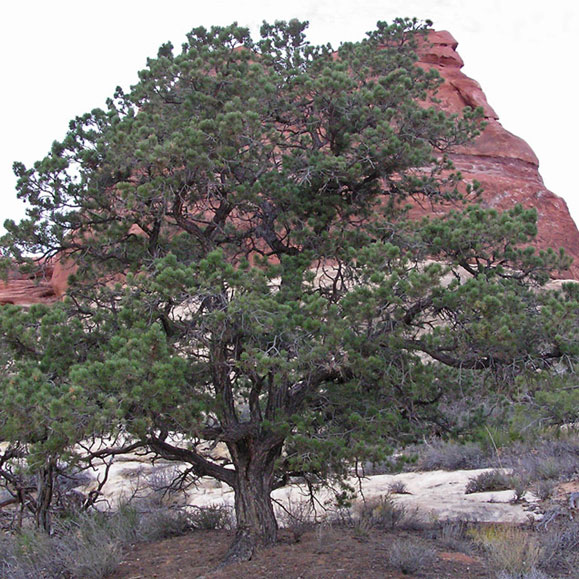
An average mature Pinus edulis specimen. Note the rounded crown of the tree and its habitat. Specimen found at Canyonlands National Park, Utah. Photo taken November 11, 2005 by Al Schneider [21].
The major economic use comes from its edible seeds, which are still widely sourced from wild trees. The nutritious seeds are edible raw or cooked and have a slightly resinous flavor [8,9]. Seeds can be ground into a meal and used in stews, baking and for nut butters [10]. The seed is an important food sources for Native American tribes due to its high protein (15%) and oil and fat content (~70%) [11, 12]. The immature female cones can be roasted, creating a soft center that forms a sweet syrupy food; the inner bark can be cooked and eaten like spaghetti, which has a sweet, nutty flavor or dried and powdered for use as a thickening agent in soups and stew and in bread making [10]. A vanillin flavoring is obtained as a by-product of other resins that are released from the pulpwood [13].
The pinyon pine has also been widely used for fuel and in the making of charcoal since the pitchy wood has a higher heat value than most other woods [7]. The gum is used in waterproofing baskets, canoes etc, for repairing pottery vessels and in making turquoise mosaics and jewelry [14, 15]. The gum has also been used as a red paint on jars and bowls [15] and a tan or green dye is obtained from the needles [16]. The gum has been used, with sumac leaves (Rhus spp.) and yellow ochre to make a black dye and ink [15].
Medicinally, the terpentine obtained from the resin of P. edulis, among other pines, is used in the form of liniment plasters and poultices on cuts, boils, burns and various skin problems [15, 16]. The heated pitch has been applied to the face to remove facial hair [15]. The gum is used as a plaster on cuts and sores [14]. An infusion of the leaves has been used as an emetic to cleanse the stomach [15]. The leaves have been chewed in the treatment of venereal diseases [15] or burnt and the smoke inhaled as a treatment for colds [15]. The inner bark is expectorant [15]. That said, caution should be had as the wood, sawdust and resins from various species of pine can cause dermatitis in sensitive people [18].
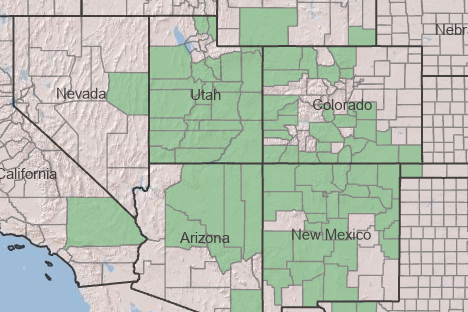
[3]
Pinyon Pine (Pinus edulis) has most recently been assessed for The IUCN Red List of Threatened Species in 2011 as Least Concern [20].
This plant can be found in warm desert biomes, and is localized to pinyon-juniper and pinyon or sagebrush and lower aspen communities between 1220 and 2745 m in its native range [2].
[1] "Taxonomy Browser (Pinus Edulis)." National Center for Biotechnology Information, www.ncbi.nlm.nih.gov/Taxonomy/Browser/wwwtax.cgi?mode=Info&id=3340&lvl=3&lin=f&keep=1&srchmode=1&unlock.
[2] Welsh, S. L. A Utah flora. 3rd ed., Brigham Young University Press, 2003. ISBN 0-8425-2556-4
[3] Bentancourt, Julio L., et al. “Fossil and Genetic History of a Pinyon Pine (Pinus Edulis) Isolate.” Ecology, vol. 72, no. 5, Wiley, Oct. 1991, pp. 1685–1697. Crossref, doi:10.2307/1940968.
[4] Frazier, Penny. "Pine Nut Varieties." Pinyon Penny's pinenut.com, pinenut.com/pine-nuts/pinon-pinyon-nuts.shtml.
[5] Wislizenus, Frederick A. Memoir of a Tour to Northern Mexico: Connected with Col. Doniphan's Expedition, in 1846 and 1847. 1848.
[6] "Pinus edulis Engelm." Tropicos, Missouri Botanical Garden, tropicos.org/name/24900305.
[7] "NCRS Plant Guide: Two-Needle Pinyon, Pinus edulis Engelm." USDA Plants Database, plants.usda.gov/DocumentLibrary/plantguide/pdf/cs_pied.pdf.
[8] Kunkel, G. Plants for Human Consumption: An Annotated Checklist of the Edible Phanerogams and Ferns. Lubrecht & Cramer, 1984.
[9] Sargent. C. S. Manual of the Trees of N. America. Dover Publications Inc. New York. 1965 ISBN 0-486-20278-X
[10] Facciola, Stephen. Cornucopia: A Source Book of Edible Plants. Kampong Publications, 1990.
[11] Usher, George. A Dictionary of Plants Used by Man. Macmillan Publishing Company, 1974.
[12] Weiner, Michael A. Earth Medicine, Earth Food: Plant Remedies, Drugs, and Natural Foods of the North American Indians. Ballantine Books, 1980.
[13] Huxley, A. The New Royal Horticultural Society Dictionary of Gardening. MacMillan Press, 1992.
[14] Whiting, Alfred F. Ethnobotany of the Hopi. North Arizona Society of Science and Art, 1939.
[15] Moerman, Daniel E. Native American Ethnobotany. Timber Press (OR), 1998.
[16] Grae, Ida. Nature's Colors: Dyes from Plants. Macmillan Publishing Company, 1979.
[17] Grieve, Maud, and Hilda Leyel. A Modern Herbal: The Medicinal, Culinary, Cosmetic and Economic Properties, Cultivation and Folk-lore of Herbs, Grasses, Fungi, Shrubs, and Trees with All Their Modern Scientific Uses. 1931.
[18] Foster, Steven, et al. A Field Guide to Medicinal Plants: Eastern and Central North America. Houghton Mifflin, 1990.
[19] USDA NRCS National Plant Data Team. "Pinus edulis Engelm. Plant Profile." USDA Plants Database, plants.usda.gov/home/plantProfile?symbol=PIED.
[20] "Pinus edulis Red List Assessment." IUCN Red List of Threatened Species, www.iucnredlist.org/species/42360/2975133.
[21] Schneider, Al. "2pied.jpg." Photograph. Southwest Colorado Wildflowers, 11 Nov. 2005, www.swcoloradowildflowers.com/Tree%20Enlarged%20Photos/2pied.jpg.
[22] Schneider, Al. "9pied.jpg." Photograph. Southwest Colorado Wildflowers, 19 Sept. 2005, www.swcoloradowildflowers.com/Tree%20Enlarged%20Photos/9pied.jpg.
[23] Schneider, Al. "5pied.jpg." Photograph. Southwest Colorado Wildflowers, 25 May 2016, www.swcoloradowildflowers.com/Tree%20Enlarged%20Photos/5pied.jpg.
[24] Schneider, Al. "6pied.jpg." Photograph. Southwest Colorado Wildflowers, 31 May 2004, www.swcoloradowildflowers.com/Tree%20Enlarged%20Photos/6pied.jpg.
